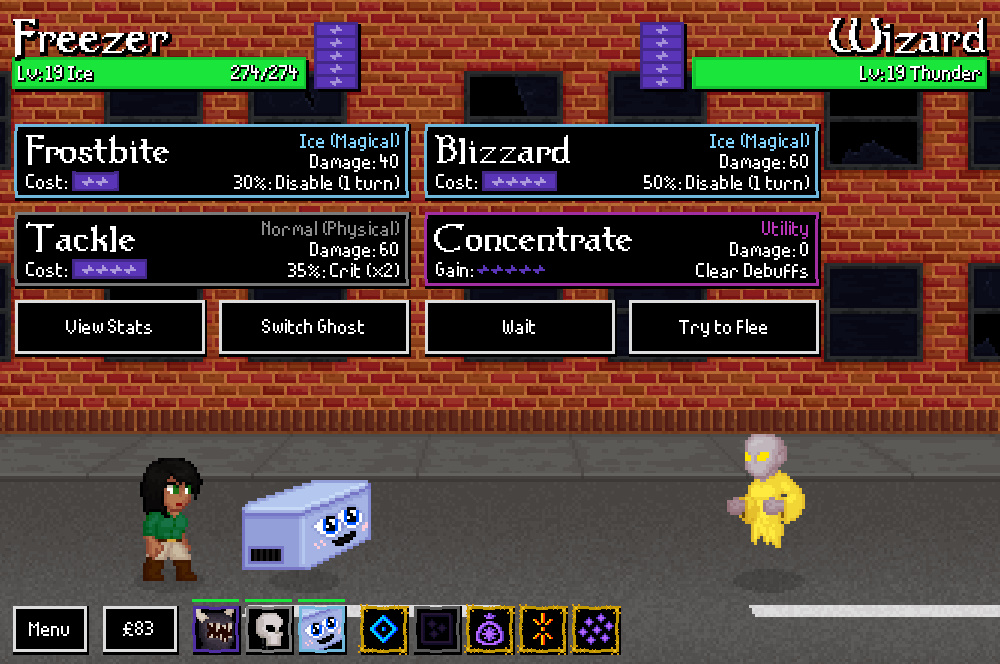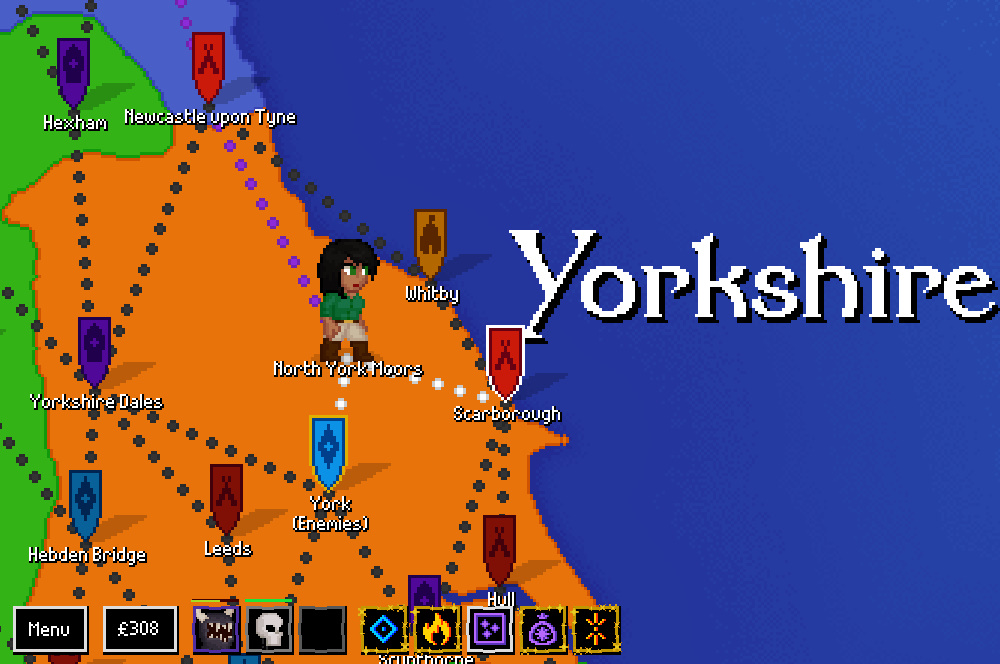Official Site || Steam Page || itch.io Page
NOTE: The Ghostlords segment of the above video starts at 33:22.
First Impression articles are based entirely upon the first roughly 30 minutes of gameplay and may not necessarily be indicative of the game as a whole. This includes the score at the end.
Ghostlords is in some ways a Pokémon game with ghosts, though it also deviates from that formula rather significantly. The game is divided into several campaigns and it seems like each of them can be completed within about two hours, give or take. I’ve only played through part of the first campaign so far, so I can’t speak for the other ones, but the story’s tone is on the darker, edgier side of things. In the first campaign, the protagonist is on a quest to rescue her husband as she fights for her life against evil future-police in an alternate version of the United Kingdom after an apocalyptic event.
Ghosts don’t work quite like the collectible monsters of other games. You start with a single ghost which you can pick from a list, I chose the default Corpse water ghost, and you can apparently use any ghost you’ve captured in one campaign as your starter in any other. There can only be three ghosts on your team at a time and there’s no storage; you need to permanently give up one of your current ghosts to get another if your team is already full. On top of this, once a ghost runs out of health it’s dead and gone forever.
On the plus side, any ghosts you defeat in combat can be recruited after the fight with no chance of failure and you don’t need to waste turns trying to capture ghosts mid-combat. Ghosts also don’t evolve into higher forms and the ones I’ve seen all seem pretty balanced so far. I really like the way these systems are implemented because they encourage you to change up your team and plan ahead. Even if you have a strong ghost you might have to at least consider giving it up for a seemingly weaker spirit if it’s low on health with no healer in sight or if the new monster has better team synergy.

Combat and leveling are handled well. Like in Pokémon games, ghosts fight one at a time and they each have a maximum of four skills at their disposal. Unlike in those games, these skills rely upon a shared regenerating energy system. You have a maximum of five energy, you regain two at the end of each turn, and the skills themselves use anywhere from zero to five energy. You can freely switch between your three ghosts and this energy pool is shared between them. Buffs and debuffs also play just as large of a role as elemental weaknesses. Thus, you can have one ghost start out with a debuff, swap to your healthiest ghost to take a hit and use a free action to regain energy on the next turn, and then swap to your strongest ghost to use a strong five energy attack on a debuffed opponent.
Each action will be labelled as “Strong” or “Weak” against the appropriate enemies, though there is no readily available elemental weakness chart within the game and with elements like “Justice” and “Robot” you’ll have to experiment with various types of ghosts to see what works best against which opponents. Critical hits play a fairly large role and every attack has its own critical rate listed on it. If you play your cards right and have a bit of luck on your side you can one-shot an enemy without taking any damage. Of course, this also means that your own ghosts are at risk whenever they face something they’re weak against and even when the weakness order is on your side a lucky critical with a strong attack can change the tide.
As for leveling, your ghosts progress in a few different ways. Every ghost in your team gets experience after each fight and levels up as usual. However, every other level also allows you to choose between three rather substantial additional stat boosts to allow for some customization. Ghosts occasionally learn new skills when they level up as well, but you have to choose between taking the stat boost or replacing one of your current skills with the new one. If you get lucky, you can encounter merchants outright selling various stat increases for any of your ghosts; these are remarkably large boosts and they come at appropriately high prices. Beyond your individual ghosts, you can carry around up to five passive relics which affect your entire team. These relics can do all sorts of things like granting you 20% more attack power when under half health or boosting experience gains and you can either buy them or find them.
Progression through the campaigns themselves is one of the most unique parts of Ghostlords. The world map is made of nodes connected by branching paths. Each of these nodes is denoted by a different type of marker like “Unknown” or “Wild Ghosts” to indicate its general focus. There’s no backtracking and you can only go downward towards your ultimate destination so you need to pay attention to both the individual choices and what they grant you access to in the future.

Once you choose a node on the world map you are taken to the area map. Just like the world itself, each area is split up into nodes which lead downward to two or three other choices and you can only descend along these paths. Regardless of the general area type, most nodes seem to fall into the “Unknown” category, which can include all sorts of things from team battles against rival ghostlords, wild ghosts, encounters with NPC’s which may result in some nice rewards, or fights against corrupt enforcers. Other node types include quests, guaranteed wild ghost fights, merchants, and healers.
This restrictive style of progression means you need to constantly make tough decisions. Do you spend money for a decent upgrade at the healer or wait for possibly getting something better at a future merchant? For that matter, do you take on a wild ghost to replace a your favorite ghost because it’s low on health or do you risk moving through a few more Unknown nodes on a different path to reach a Healer node down the line? The random factors at play give this game quite a bit of replay value since each run through a campaign is going to be different. Though I never lost my full team of ghosts, there’s a Hardcore Mode option which ends the campaign if you’re defeated so I assume you normally get sent back to the start of your current area if you lose.
I was rather on the fence about buying Ghostlords, but I’m glad I decided to do so. Even with only about 30 minutes of playtime, I can tell that this is a game which is willing to take innovative risks with everything from its combat system to its general form of progression and it succeeds in its execution.
First Impression Verdict: Great! 5/5